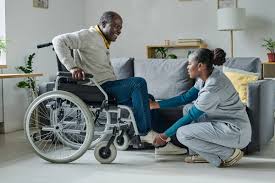Living independently is a cherished aspect of adulthood, yet for many people with disabilities, it remains a challenging goal. However, advances in smart home technology are changing this narrative, offering new opportunities for autonomy and ease in daily living.
These technological innovations are not just conveniences but lifelines that transform living spaces into empowering environments for those with disabilities.
What is Smart Home Technology?
Smart home technology refers to a set of devices and systems interconnected via the internet, allowing remote management of various home functions.
The fundamental principle behind this technology is the Internet of Things (IoT), where everyday objects are equipped with network connectivity, enabling them to send and receive data. This connectivity not only facilitates the remote control of devices but also allows them to interact with each other, creating a cohesive and intelligent home ecosystem.
Today’s smart homes feature advanced sensors, artificial intelligence, and machine learning algorithms that enable them to learn from user habits and preferences, adjusting settings automatically for optimal comfort and efficiency. This continuous evolution has made smart technology increasingly intuitive and user-friendly, allowing it to seamlessly integrate into daily life and become more accessible to a wider range of users, including those with disabilities.
The Role of Smart Home Modifications in Assisting People with Disabilities
Smart homes have emerged as a vital tool in aiding individuals with disabilities, bridging the gap between their abilities and the demands of daily living. These technologies provide an unprecedented level of control over the home environment, effectively reducing physical barriers that can impede independence.
For instance, voice-controlled thermostats offer a significant benefit for those with mobility issues, allowing them to regulate their environment without physical exertion.
Alert systems tailored for individuals with hearing impairments are another excellent example, where visual or tactile alerts can replace auditory cues, ensuring that critical notifications are not missed.
Additionally, automated door openers and window controls can be life-changing for those with limited upper-body mobility, granting them effortless access to their surroundings. These real-world applications of smart home technologies highlight their potential to significantly enhance the quality of life for people with disabilities, fostering greater independence and self-reliance.
Key Smart Home Features Beneficial to People with Disabilities
Certain smart home features stand out for their particular benefits to individuals with disabilities:
Voice-Activated Systems
These systems are invaluable for individuals with mobility or dexterity challenges. By using simple voice commands, users can control various aspects of their home, such as turning on the TV, making phone calls, or controlling lights, which greatly enhances their ability to manage their living space independently.
Automated Lighting and Temperature Control
Managing a home’s lighting and temperature can be a challenge for those with physical limitations or sensitivity to light and temperature. Automated systems can adjust these settings based on preset preferences or sensors, ensuring a comfortable and safe living environment.
This automation not only adds convenience but also plays a crucial role in maintaining a stable and suitable environment for those with specific health conditions.
Smart Security Features
For individuals with disabilities, especially those living independently, security is a paramount concern. Smart security features like cameras, motion sensors, and automated locks provide enhanced safety and peace of mind. These systems can be monitored and controlled remotely, offering an added layer of security without the need for physical interaction.
For those with vulnerabilities due to their disabilities, such smart security systems are not just about preventing intrusions but also about creating a sense of safety and control over their personal space.
Choosing the Right Smart Home Solutions
Step 1: Assess Individual Needs
Begin by evaluating the specific needs associated with the disability. For example, voice-activated devices are ideal for individuals with visual impairments, while those with mobility challenges might benefit more from automated door openers and adjustable countertops.
Consider daily routines and identify areas where smart technology could offer significant assistance.
Step 2: Research Compatible Technologies
Investigate smart home devices that can integrate seamlessly with any existing assistive technologies or medical equipment.
Look for systems that support a range of functionalities and can be easily connected to other devices.
Step 3: Focus on User-Friendliness
Ensure the chosen technology is intuitive and straightforward to use. This is crucial for people who may not be familiar with advanced technology.
Consider devices with simple interfaces, clear instructions, and responsive customer support.
Step 4: Verify Integration and Compatibility
Check how new devices will fit into the existing home environment. This includes compatibility with current smart systems, Wi-Fi networks, and mobile devices.
Opt for technologies that offer flexibility and can adapt to various setups.
Step 5: Prioritize Support and Maintenance
Choose manufacturers or vendors that provide reliable customer support, including installation assistance and ongoing maintenance.
Look for products with accessible customer service, including troubleshooting and technical help.
Step 6: Plan for Installation and Setup
Arrange for professional installation if necessary, especially for complex systems like automated door openers or security systems.
Ensure that the setup process is handled efficiently, with minimal disruption to the household.
Step 7: Continuous Evaluation and Adjustment
After installation, regularly assess how well the technology is meeting the individual’s needs.
Be open to making adjustments or adding additional features as required.
The Impact of Smart Home Technologies on Quality of Life
The impact of smart home technologies on the lives of individuals with disabilities is profound and far-reaching. These technologies go beyond mere convenience; they provide essential support that can drastically enhance daily living.
Personal accounts from users who have regained significant levels of independence through these technologies are both inspiring and indicative of their transformative potential.
For example, individuals with severe physical disabilities have shared stories about how smart home technology has enabled them to perform everyday tasks on their own, fostering a sense of self-reliance and confidence.
Research studies corroborate these personal narratives, showing tangible improvements in autonomy and well-being among users of smart home technologies. These studies often highlight not only the physical benefits, such as the ability to control one’s environment, but also the psychological and emotional benefits, such as increased feelings of security and decreased dependence on caregivers.
This is especially critical for individuals who value their independence but are limited by their physical capabilities. The integration of smart home technology in their living spaces has shown to improve overall life satisfaction, demonstrating that these advancements are not just technological triumphs but are also instrumental in enhancing human dignity and quality of life.
Challenges and Considerations in Smart Home Adaptation
Adopting smart home technology, while beneficial, comes with its own set of challenges and considerations.
One of the primary concerns is the cost. Advanced smart home systems can be expensive, potentially placing them out of reach for some individuals. However, it’s important to explore potential financial assistance options, such as grants, subsidies, or insurance coverage, which can make these technologies more accessible.
Another significant concern is privacy and security. As smart devices are interconnected and often internet-enabled, they are susceptible to data breaches and hacking. Users must be vigilant about the security measures of their devices, ensuring strong passwords and regular software updates.
Furthermore, the complexity of some systems can be daunting, particularly for those not accustomed to digital technology. Ensuring user-friendly design and providing comprehensive training and support is crucial to address this challenge.
How to Get Started with Smart Home Modifications
Beginning the journey towards a smart home tailored for disability needs involves a few key steps.
First, a thorough assessment of individual needs and challenges is essential. This can include identifying mobility restrictions, sensory impairments, or any other specific requirements that smart technology can address.
Next, researching the available technologies and their capabilities is crucial in determining what solutions best fit these needs. It’s important to stay updated on the latest developments in smart home technology to ensure the most effective systems are considered.
Consulting with professionals who specialize in smart home solutions for people with disabilities is also highly beneficial. These experts possess the knowledge and experience to suggest the most suitable modifications and assist in the implementation process. They can provide insight into the best products and strategies for creating a home environment that enhances independence and quality of life.
Conclusion
Smart home technologies are not just about the convenience of controlling a thermostat from your phone or automating lighting. For people with disabilities, they represent freedom, independence, and the possibility of living a life less hindered by physical limitations.
As we look to the future, the prospects for smart home technology in facilitating independent living for individuals with disabilities are not just promising but revolutionary. With each advancement in technology, from more sophisticated AI to increasingly intuitive user interfaces, we edge closer to a world where disability does not dictate one’s ability to live independently.
This evolution of technology is paralleled by a growing societal recognition of the importance of accessibility and inclusivity, further driving innovation and adoption in this field.



